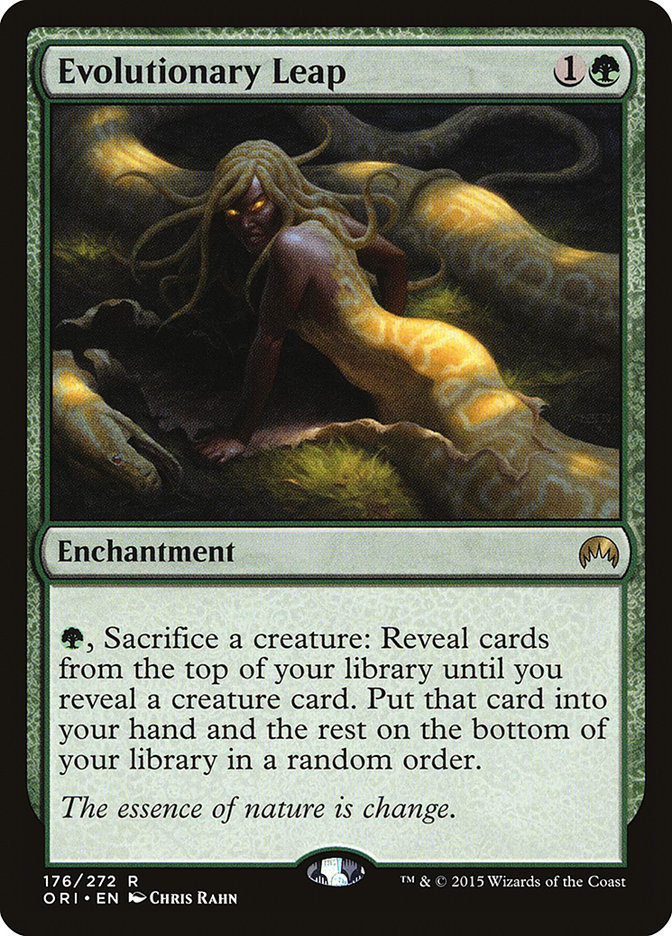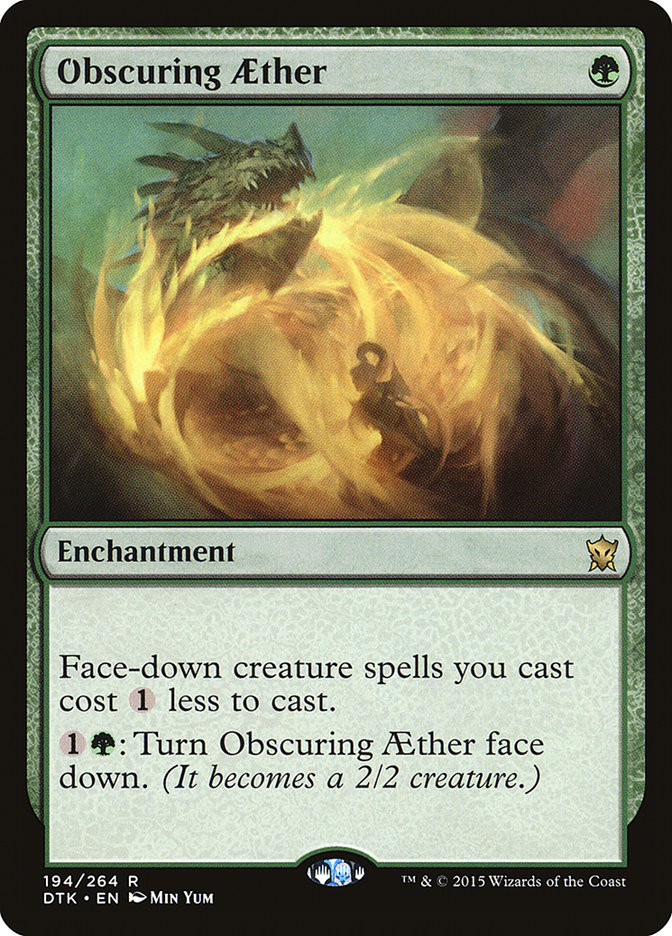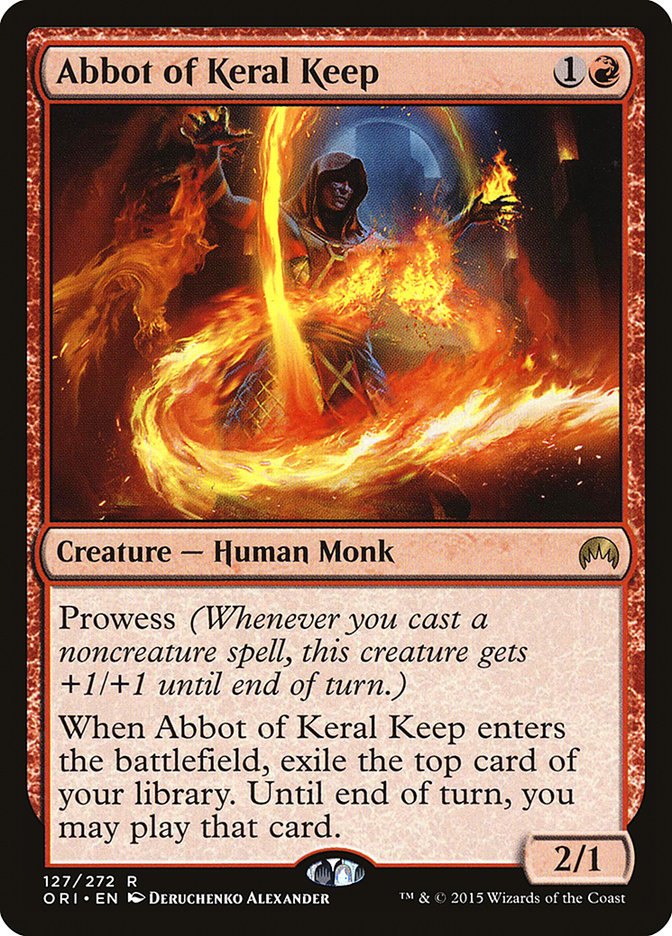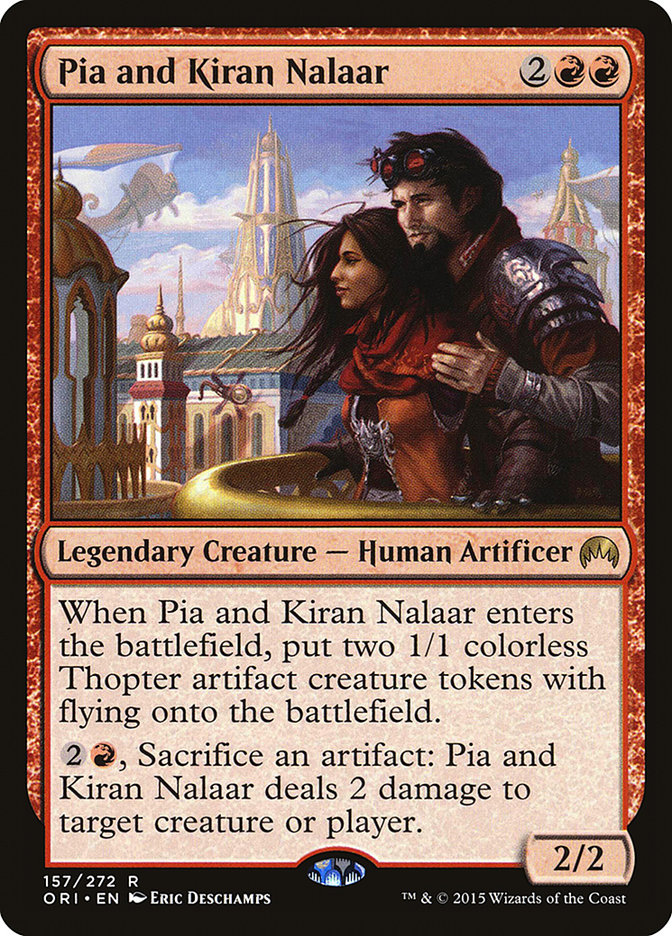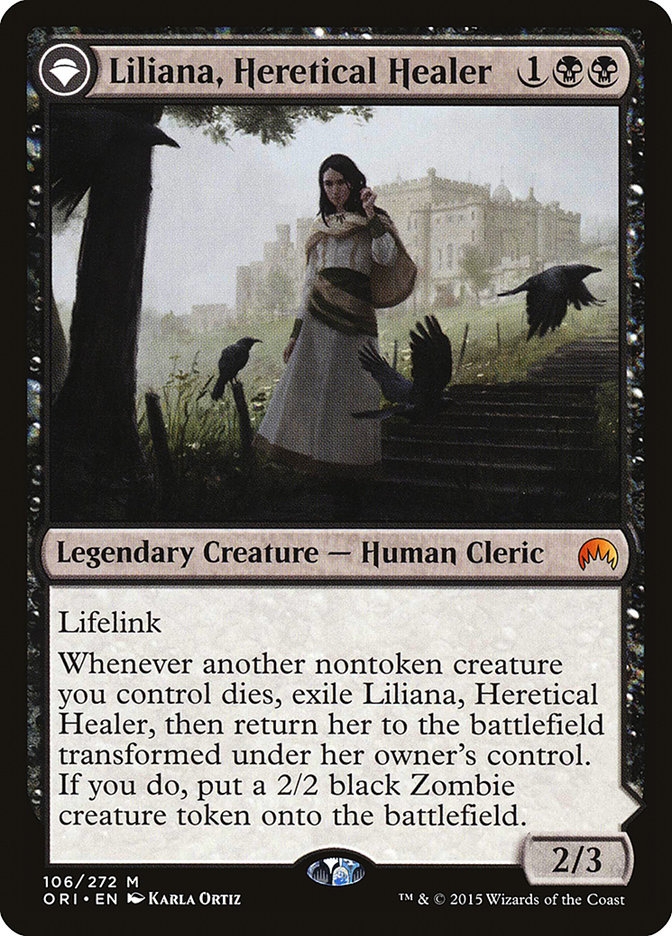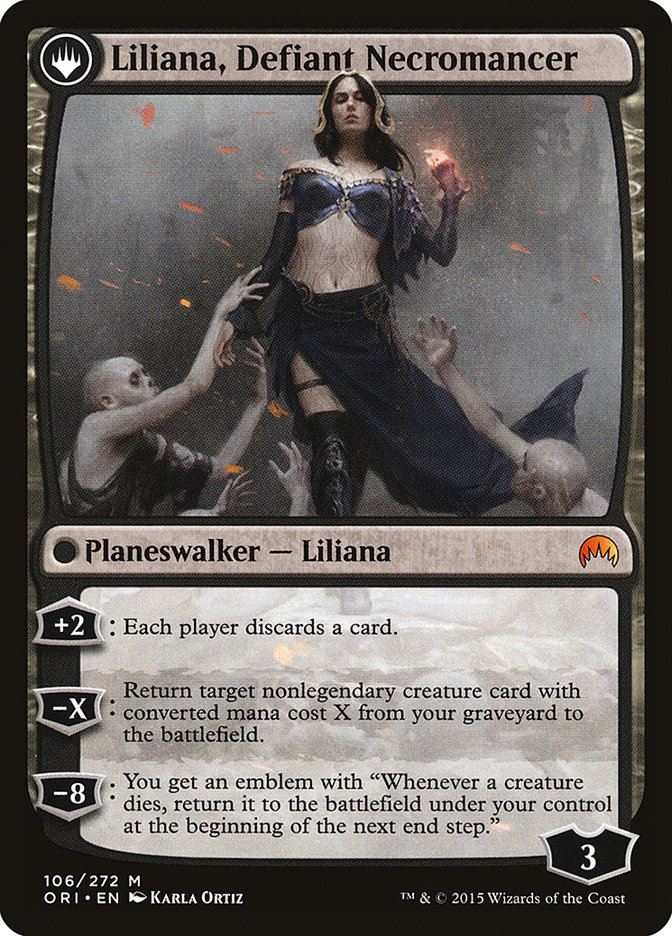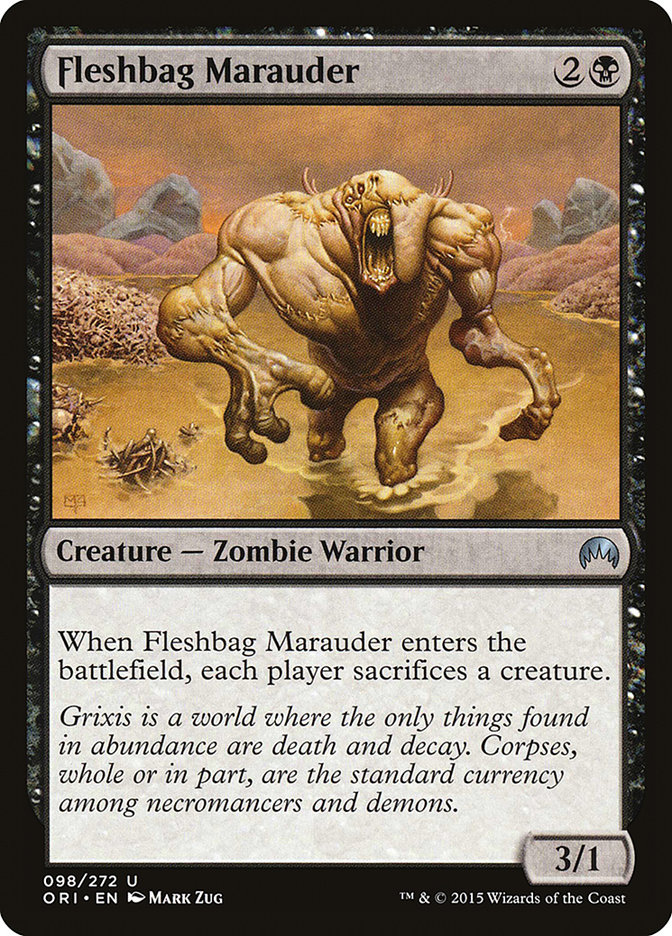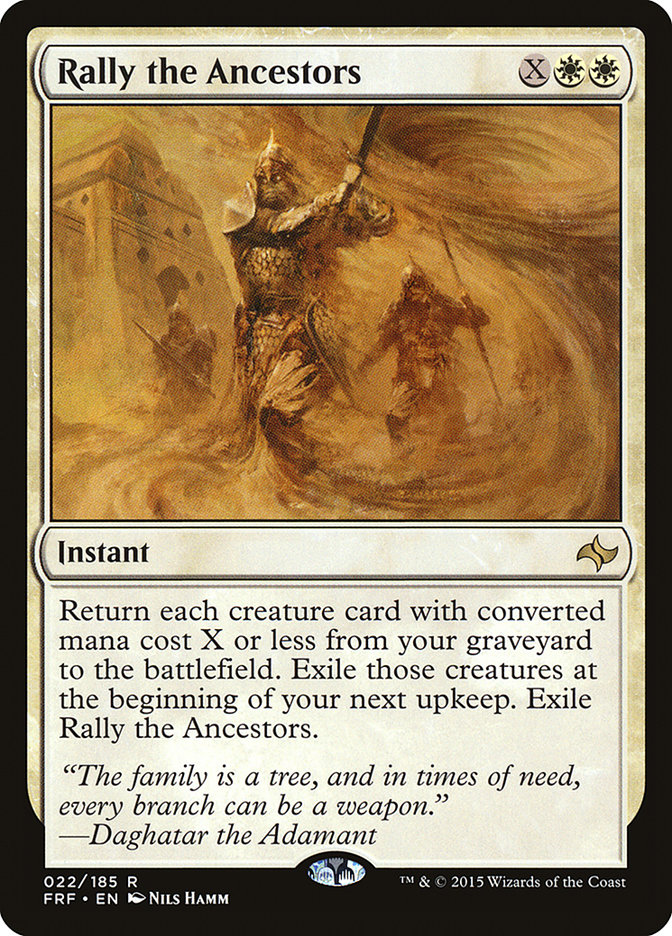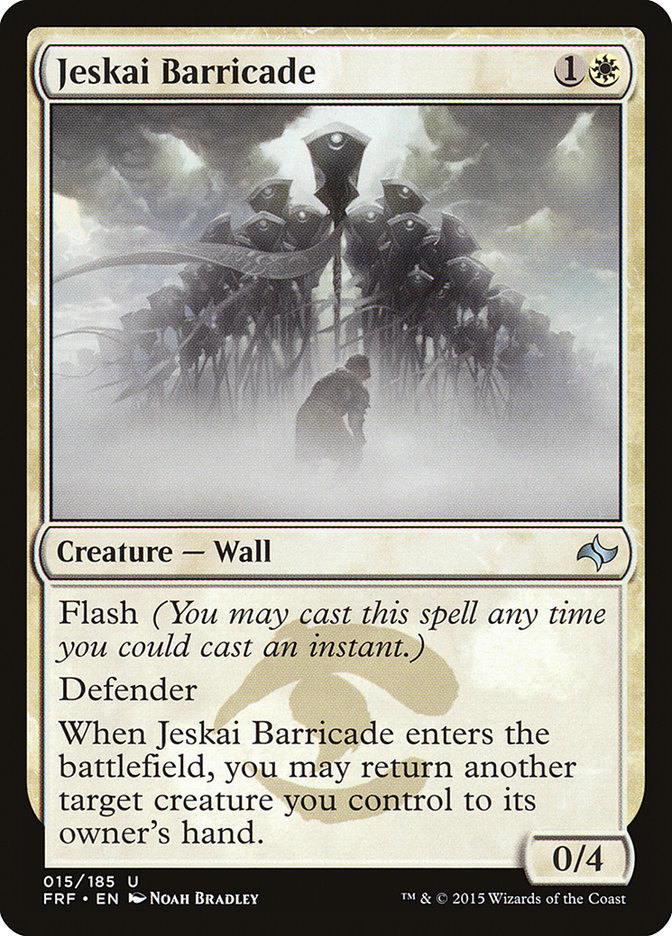With the Magic Origins prerelease on the horizon and the spoiler completely revealed, we have all of the information we require to begin preparing for week one of the new Standard format, which will debut at the Open Series in Chicago. As we began to discover last week, the final core set in the history of Magic has no shortage in powerful “build-around-me” engines, and the card we’re discussing today is no different.
Clearly Survival of the Fittest this is not, but they do have a striking number of similarities:
- Implications for deckbuilding are huge – every creature that goes into your deck must have a purpose, thanks to the fact that Evolutionary Leap does not have the pinpoint accuracy of Survival.
- With the same mana and activation costs, history has proven that this is a sustainable tax on your mana to jump-starting an engine – Evolutionary Leap is not too expensive to use.
- Evolutionary Leap carries all of the strengths and weaknesses of being an enchantment. Most notably, it is a target for both Commune with the Gods and Dromoka’s Command.
Where do the distinctions lie?
- Evolutionary Leap does not require creatures in hand. You can continue to build your board presence ad nauseam and recycle your threats should they come under pressure. We are not required to hold creatures in reserve should Leap be drawn later in the game.
- Further, and critically, because Leap does not require creature cards, it can utilize tokens. As a result, there is potential to build decks that play a small number of specific creatures and retrieve them consistently.
- It is a cheap and repeatable sacrifice engine. These types of effects are usually not granted lightly, and there is a great deal of design space to explore specifically with Liliana, Heretical Healer.
So where does that put us? My first inclination would be to try to target a cheap recursive threat that can exponentially increase my threat density when repeatedly cycled through Evolutionary Leap.
Oh, right…
Creatures (18)
- 1 Gaea's Revenge
- 1 Hornet Queen
- 4 Satyr Wayfinder
- 3 Rattleclaw Mystic
- 1 Dragonlord Atarka
- 4 Den Protector
- 4 Deathmist Raptor
Lands (24)
Spells (18)

This is more of a means to prove a point. When the “worst-case scenario” in activating Evolutionary Leap is finding Satyr Wayfinders to fuel your Megamorph engine, not only are we able to quickly assemble an army of Raptors which can then in turn be used to find your big bullets, we will also have a slew of Den Protectors that can not only bring our Raptors back but create a chain of top-end threats. This can be complimented by something as simple as Hordeling Outburst or just by playing a few more value creatures like Elvish Visionary.
Another fine addition to this “Chaining Raptors” mentality is my best pal who will introduce the next portion of this week’s piece. Here come the Purphoros decks:
Creatures (20)
- 2 Purphoros, God of the Forge
- 4 Satyr Wayfinder
- 4 Rattleclaw Mystic
- 2 Stratus Dancer
- 4 Den Protector
- 4 Deathmist Raptor
Lands (23)
Spells (17)
Sideboard

You may recall seeing some variations of the Temur shard and different flavors of pushed Megamorph decks several months ago, and although they never really made a sustainable splash I think we might see that change with Evolutionary Leap. There is no longer a requirement to play extraneous subpar creatures when we can just play a straightforward, fluid engine. Cards that would typically be a huge problem to break through, like Elspeth, Sun’s Champion, can either be entirely circumvented or killed with Purphoros and Leap’s ability to keep turning your Deathmist Raptors into additional copies and other Megamorph creatures.
Obscuring Aether is some borrowed technology from those old lists that serves several purposes – it powers up your Megamorphs, Commune with the Gods, and insulates you from Dromoka’s Command. However, most importantly, it is an additional “fake creature” to get Evolutionary Leap moving in a pinch.
The sideboard is incredibly rough, but I do want to highlight Nylea’s Disciple and its implications in regards to Evolutionary Leap. It is not unreasonable to configure your deck in a sideboard scenario where it is possible to be drawing a Disciple every other turn, or to just make your singular Disciple’s trigger close out the game. Narrow but high-impact creatures are going to have a much larger place in these types of shells.
Let’s move away from Deathmist Raptor for a moment and look at how a pushed tokens deck might work:
Creatures (12)
- 2 Purphoros, God of the Forge
- 4 Goblin Rabblemaster
- 1 Chandra, Fire of Kaladesh
- 1 Pia and Kiran Nalaar
- 4 Abbot of Keral Keep
Lands (24)
Spells (24)

Abbot of Keral Keep may not be the high-functioning Elvish Visionary I desire since it has a high chance of missing early in the game, but this type of Big Red/Burn hybrid strategy leveraging Leap as a means to find Purphoros and essentially never run out of gas looks exciting to me. While it is often possible to answer the first or even the second Goblin Rabblemaster, I suspect it will be problematic for most opponents when its trigger is finding the replacements.
On the surface of things, Chandra’s parents should be a powerful compliment to Purphoros, but with little means to utilize their ability in this deck I’m not so sure they have a place here – without the one true red god in play, they’re just not that special here.
That being said, perhaps we can model some sort of hybrid with the list I talked about when I first talked about them:
Creatures (22)
- 2 Ornithopter
- 1 Purphoros, God of the Forge
- 4 Satyr Wayfinder
- 4 Rattleclaw Mystic
- 4 Den Protector
- 4 Deathmist Raptor
- 3 Pia and Kiran Nalaar
Lands (22)
Spells (16)

Is there too much going on here? Probably, but it also goes to show that our conception of these linear “theme decks” has to change. It’s so easy to include multiple of angles of attack with overlapping engines that it would be foolish not to see how deep we can actually go. Also, Pyromancer’s Goggles is just awesome and I haven’t been able to post a list with it yet.
Now let’s take a look at the Liliana decks:
Creatures (22)
- 4 Fleshbag Marauder
- 2 Elvish Visionary
- 1 Hornet Queen
- 1 Courser of Kruphix
- 4 Satyr Wayfinder
- 2 Doomwake Giant
- 2 Den Protector
- 4 Liliana, Heretical Healer
- 2 Nissa, Vastwood Seer
Lands (24)
Spells (14)

At first glance it would appear that the best way to utilize Liliana is to aggressively try to lock your opponent. In this case, by alternating between her symmetrical discard and reanimating Fleshbag Marauder, we are essentially imitating Liliana of the Veil in Standard. The reasons this can work long-term are twofold: first, that Evolutionary Leap allows us to flip her as an instant to avoid removal spells, and second, her synergy with Whip of Erebos. Whip of Erebos essentially designates that as long as you have Evolutionary Leap and the necessary mana, you can flip the Heretical Healer every single turn, generating a Zombie along with the rest of this nonsense. I’ve even considered going down a road involving Deadbridge Shaman for the real soft lock.
This is a value-generation deck, as once your pieces are in place and you’ve slowly stripped away your opponent’s resources you can largely win at your leisure even if it may take a while. Nissa, Vastwood Seer alleviates this to some degree by being another excellent card in conjunction with Whip of Erebos. Doomwake Giant, which also triggers off your straggler enchantments, is largely to keep cards like Goblin tokens and Elspeth in check, ensuring your Fleshbag Marauders will remain effective.
There are, as you would suspect, quite a few ways to explore this basic shell. Siege Rhino hasn’t stopped being good:
Creatures (24)
- 2 Elvish Visionary
- 2 Hornet Queen
- 3 Sylvan Caryatid
- 3 Courser of Kruphix
- 4 Satyr Wayfinder
- 2 Doomwake Giant
- 4 Siege Rhino
- 3 Liliana, Heretical Healer
- 1 Nissa, Vastwood Seer
Lands (24)
Spells (12)

Rather than attempting to lock our opponent under Liliana long-term and grind them with Fleshbag Marauders, we’re really just interested in brute forcing them dead with Siege Rhinos over and over again. There are a lot less cute and obscure pieces, but perhaps those just aren’t necessary if you can average five Siege Rhinos a game.
Speaking of using Siege Rhino repeatedly, did you miss this deck? I sure have.
Creatures (26)
- 2 Fleshbag Marauder
- 4 Sylvan Caryatid
- 2 Purphoros, God of the Forge
- 4 Satyr Wayfinder
- 4 Siege Rhino
- 4 Jeskai Barricade
- 3 Den Protector
- 3 Liliana, Heretical Healer
Lands (23)
Spells (11)

I’ve discussed this deck before, but we’ve acquired quite a few new toys. On the surface, Evolutionary Leap is a value Rally’s dream; if we haven’t killed our opponent, it’s probably not too difficult to rip nearly every single creature out of deck and send all the ones that have entered the battlefield this turn back into the graveyard. Now we’re either flush with gas or probably just have another Rally ready to execute a kill.
Evolutionary Leap also helps to solve the “Jeskai Barricade problem.” That is, Barricade is subtly one of the more powerful cards in the deck, allowing you to re-buy your value creatures, but a lot of its power was hinged on having to play Wall of Mulch to sacrifice it. That is no longer the case. It also allows us lines like reanimating Den Protector with Liliana, Defiant Necromancer then immediately bouncing it to Megamorph for yet another card out of our graveyard.
Is this deck all of a sudden a premier strategy? That’s pretty unlikely, but as I alluded to previously, there’s a lot that Evolutionary Leap can do to further existing decks. Who knows? Maybe the resurgence of a new tribe will be the one to put Leap/Rally on the radar?
Creatures (26)
- 4 Elvish Visionary
- 4 Elvish Mystic
- 4 Satyr Wayfinder
- 1 Nyx Weaver
- 4 Siege Rhino
- 3 Nissa, Vastwood Seer
- 2 Dwynen's Elite
- 4 Shaman of the Pack
Lands (23)
Spells (12)

Constructing this deck is a lot trickier than it looks, but there’s potentially a lot of reward for us abandoning the clunky Purphoros kill and just playing some honest Elves and X’ing our opponent out of the game with Shaman of the Pack. Dwynen’s Elite may actually be more important than I currently believe, as it generates two bodies to buy time with and helps to deal more damage with Shaman of the Pack and grants us two activations of our Evolutionary Leap. Siege Rhino may look a touch out of place, but it is still obviously powerful with Rally the Ancestors and buffs our early game. Contextually, it does count as three elves most of the time after all. Nissa, unsurprisingly, is also excellent for both her creature type and for smoothing out our deck – she even grants us access to an alternate victory condition should the game ever progress to the point where she flips and starts ticking up loyalty. Even if she were to die in her true planeswalker form, she can still contribute to a Rally later!
As a bonus decklist, I have been working on various Demonic Pact strategies since last week, and here’s where I’m at:
Planeswalkers (2)
Lands (27)
Spells (31)

While I originally assumed Sultai would perform best thanks to its increased number of ways to deal with Demonic Pact, U/B Control proved to be far less clunky and had better access to cheap interaction. Not only that, our Demonic Pacts actually haven’t been that difficult to remove. Between the incidental ways that you’re interacting with your opponent anyways (Perilous Vault, Ugin) and Dig Through Time helping us find a Void Snare in a pinch, Demonic Pact has proven to be an incredible tool for pulling ahead and putting games out of reach. If last week wasn’t enough to give you an indication, I’m beyond excited to see how this Mythic rare pans out over the course of Magic Origin’s tenure with Standard.

